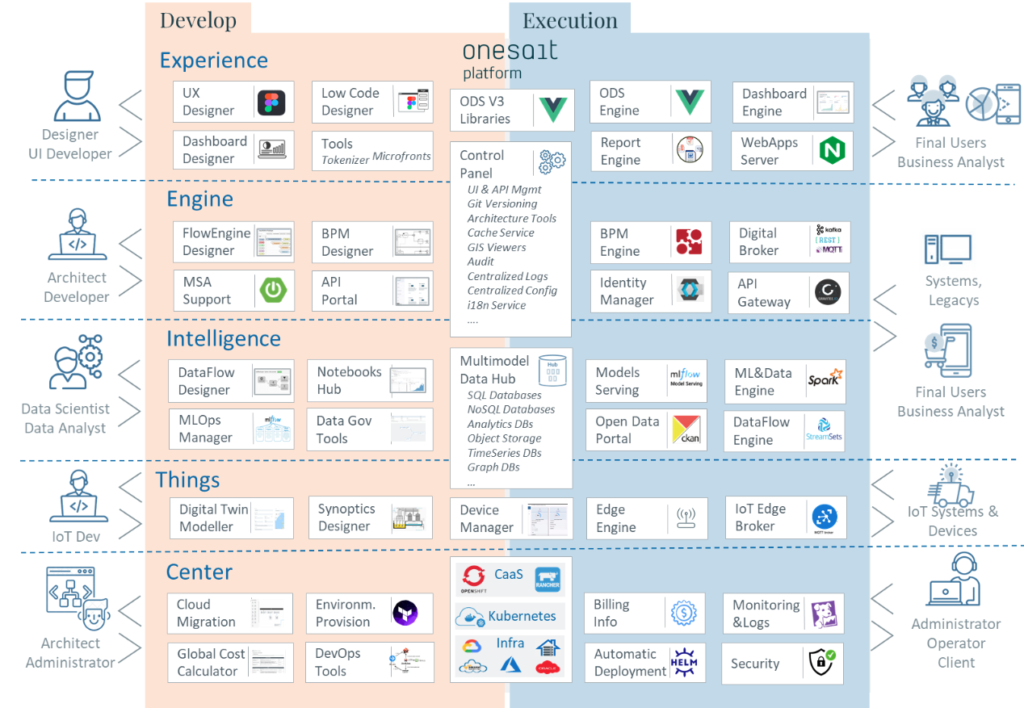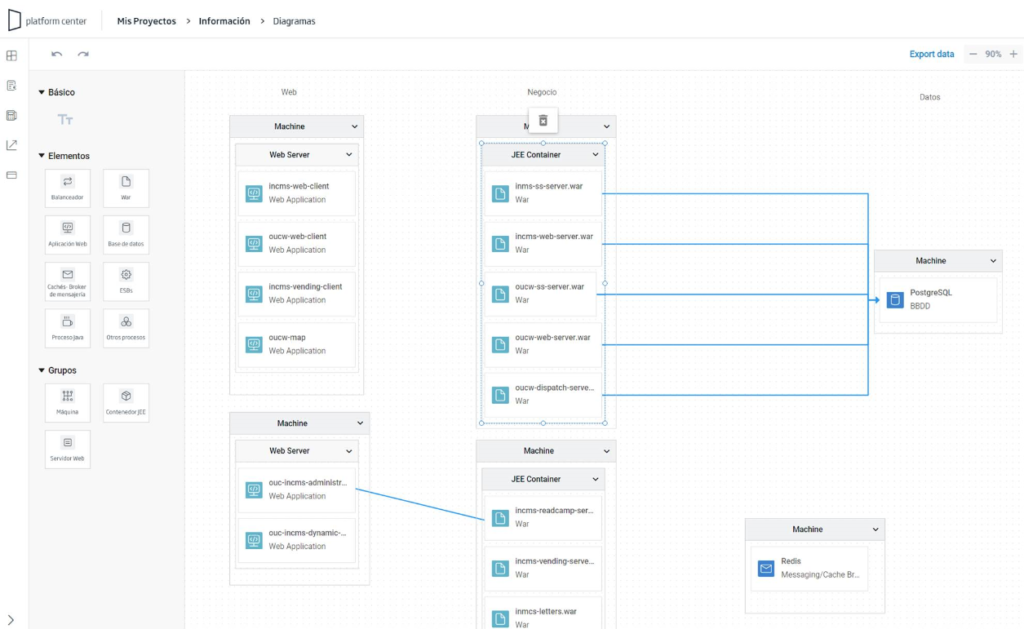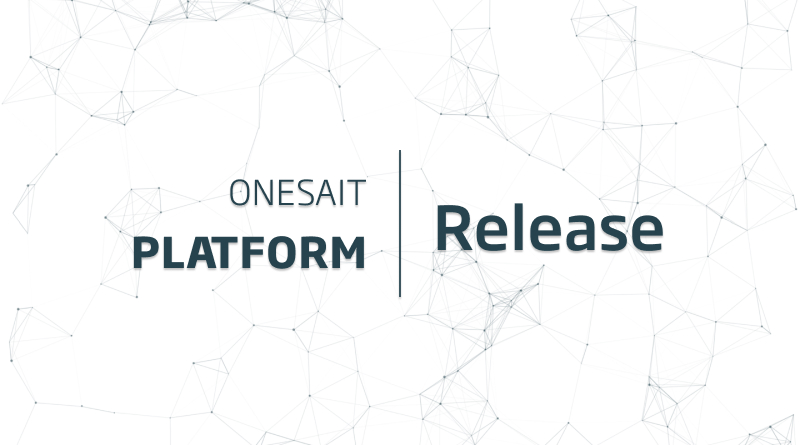Release 4.2.0-Predator for Onesait Platform
After a well-deserved vacation, we are making a comeback and, to end this Q3 on the right foot, we have launched the latest iteration of the Onesait Platform, which reaches version 4.2.0 and which The Community™ has decided to call «Predator», following our versioning policy.
As usual, if you want to know what we are working on, be sure to take a look at our 2022 Roadmap, and don’t forget that you can find more information about the Platform’s capabilities in the new Developer Portal.

Well, now that the typical opening is done, let’s see what’s new in this latest version.
Engine
In this distribution, we apply agile and low-code strategies for the development and integration of business solutions, based on standards, independent of specific cloud vendors, and deployable on IaaS, SaaS or On-Premise infrastructures:
- Scalability and stability of any infrastructure.
- The data in the center.
- Integrated end-to-end security.
Throughout this third period of the year, we have worked on the following points:
New audit module with query metrics
We have created a new audit module in the Platform that is responsible for receiving all the audit events from the rest of the modules, and processing them asynchronously, freeing the Semantic Broker from this task and, therefore, increasing its performance.
Besides, this new module incorporates a system of metrics for queries in order to have a greater control over the queries that are executed in the system. These metrics are stored in the «QueryMetrics» entity/ontology:

By storing this information in a system entity, Dashboards can be created and decisions can be made based on certain events, such as query errors, very high response times, etc.
You can find more information about it in the Audit & Metrics section of the Development Portal, and specifically in the article New Auditing Module with Query Metrics.
Evolution of the Application/Project concept
The concept of Project or Application in the Platform, allows the creation of a collaborative environment in which users with different roles can create the Platform concepts grouped together, also allowing to assign a security domain, a web application, etc., from a single point.
You can find this menu in Development > My Applications:

In the graphic interface of «My Application», you will be able to register all the concepts that can be managed via the Application. Let’s see it this way:

You can find more information about it in My Applications/Projects of the Development Portal.
Flow Engine upgraded to NodeRED 3
In this version of the Platform, the execution engine of the Flow Engine based on Node-RED has been migrated to version 3.0, specifically to version 3.0.2. This allows you to use all the new capabilities and improvements of the new engine, from the FlowEngine.

We discuss it in more detail in this Dev Portal guide.
License Manager: License Validator
We have implemented the license validation functionality that offers a REST API to validate the license file and to obtain its license information:

If you are interested in this new functionality, be sure to read the article about it that we have in the Development Portal.
Integration of MSK as a Kafka engine for the Platform
Amazon Managed Streaming for Apache Kafka (MSK) is Amazon’s fully managed Kafka service. From this version onward, the Platform can work with MSK as a Kafka cluster just like it does with other Kafka clusters.
INTELLIGENCE
We virtualize and simplify access to data between organizations, departments and systems, achieving a 360º view of business entities, and facilitating their exploitation through real-time rules, execution of complex algorithms or traditional analysis:
- Unique multi-repository data model.
- Collaborative environment for Data Scientists.
- Access, management and consumption of APIs.
We have oriented the work of this quarter in the following functionalities:
Integration of NebulaGraph as graph database
In this release, a graph database has been integrated into the Platform. The selected technology has been NebulaGraph, an open source graph database (based on Apache 2) capable of hosting large graphs, and designed to offer high performance and to simplify the use of graphs.
The Platform allows working with the graphs as with the rest of the Platform’s entities, allowing their representation, APIfication, loading, etc., from the Platform’s own tools.

You can find more information on how to use this type of entities from the Platform in this article that you’ll find in the Development Portal.
New data labeling tool
We have integrated a data labeling engine, which will allow the information stored in the Platform to be labeled, specifically based on the files (stored in the FileRepository or MinIO) or the entities stored in the Platform’s repositories.
For this, we have integrated Label Studio, an open source data labeling tool. It allows you to tag data types such as audio, text, images, videos, and time series with a simple user interface, and then export to several model formats.

You can find more information about this in the Data Labeling Tool article on the Development Portal.
Center
With Center, you can manage the deployment and operation of your Solutions in your preferred cloud, it provides you with tools to facilitate the migration to the Cloud of your Legacies:
- Simplifies migrations to the Cloud.
- Centralizes the DevSecOps ecosystem.
- Manages the deployment of reusable functional accelerators.
After the initial version of the Control Center, this quarter we have focused on these lines of work:
Onesait Platform Center Release
This quarter we have published the first release of Center, focused on the use case of modernizing existing systems.
But what’s this «Center» thing? We have an entry about it in mind, but for now, be sure to take a look at this article about Center in the Development Portal.
Application Evaluation
The objective of the Assessment is to identify all the elements of the current system.

More information about it in this article about the assessment diagram in the Development Portal.
Application containerization diagram
Once the parts of the system have been identified in the evaluation phase, this diagram allows the containerized images of the parts to be built, versioned and published in a registry for download in the cloud environment.

You can find more information in this article of the Development Portal.
Chart Helm generation diagram for Kubernetes
Onesait Platform Center proposes the deployment of our applications in Kubernetes, and for this it integrates a diagram that allows you to easily create Chart Helm diagrams.

We explain this in detail in this other article on Helm diagrams for Kubernetes deployments.
Deployment diagram on a Kubernetes cluster
Once the diagram has been created from the Center, it is possible to display the Chart Helm generated from a Diagram in the project environments.

Once again, in the Development Portal you can find an interesting article about it.
Commuity
Onesait supports Open Source technologies to create community and ensure independence. Throughout this third quarter of 2022, we have worked on the following:
- Publication of release 4.0.0-CE: version 4.0.0 Community of the Platform is now available in our Github repository.

- Updated CloudLab instance with version 4.0.1-Nitroball.





Pingback: Release 4.3.0-Quest for Onesait Platform – Onesait Platform Community